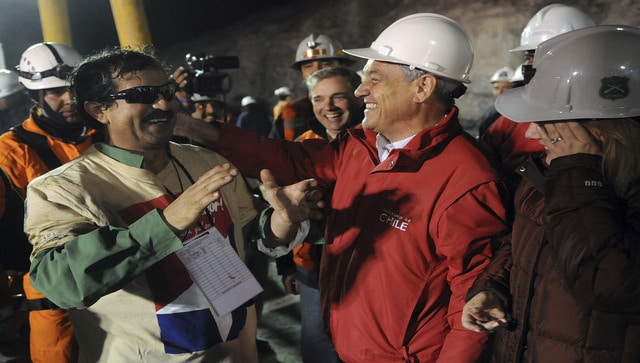It was a daring rescue operation. But in the end, their families’ anxious wait was over after 17 days as all 41 construction workers trapped after a portion of the Silkyara tunnel in Uttarakhand’s Uttarkashi collapsed and were brought to safety on Tuesday evening (28 November). The men are currently at a hospital for a fuller medical examination. The final hours of their rescue operation brought the nation together with everyone glued to their screens to witness these men see the light of the day. This heroic rescue mission in Uttarakhand reminds us of similar past endeavors that grabbed the world’s attention. Let’s take a closer look at them. 2023 Uttarakhand tunnel collapse As many as 41 construction workers were trapped by the debris of about 60 metres after a landslide on 12 November led to a part of the Silkyara tunnel caving in. These workers were provided oxygen, food and water through a pipe inside the tunnel. Rescuers made several attempts for days, including bringing a US-made augur machine to dig through the debris. However, they met several obstacles. After machines failed, it was humans – rat-hole miners – who finally completed the rescue operation..
Munna Qureshi, the rat-hole miner who removed the last rock to reach the trapped men, told the media: “They hugged me, cheered in applause and thanked me profusely”. It was not just them but the entire India that erupted in applause once all the construction workers returned to safety. ALSO READ:
The heroic men behind the Uttarakhand tunnel rescue mission
2023 American caver’s rescue A researcher from the United States was rescued nine days after he fell ill inside a cave in southern Turkey in September. American caver Mark Dickey, 40, suffered sudden gastrointestinal bleeding 3,400 feet deep inside the Morca cave in Turkey’s Taurus mountains. An international team of 200 rescuers from Turkey, Croatia, Italy and other countries took nine days to rescue the researcher from Turkey’s third-deepest cave. As per Al Jazeera, rescuers faced certain challenges during the rescue mission, such as steep vertical parts inside the cave and steering through mud and water at low temperatures in the cave’s horizontal sections. The complex part of transporting Dickey to the surface involved 90 people and took only over two days, reported National Geographic. 2018 Thai cave rescue The Thai cave rescue had grabbed the public’s attention across the globe for weeks. On 23 June 2018, a boys’ soccer team and its coach were exploring the Tham Luang Nang Non cave complex in northern Thailand when a heavy downpour inundated the tunnels, trapping all of them. Two British divers were finally able to locate the 12 boys and their coach after eight days of gruelling search. As the water levels kept going up inside the cave, it further complicated the rescue operation. The survivors were finally evacuated from the cave while heavily sedated to avoid any panic, sources told BBC. [caption id=“attachment_13444992” align=“alignnone” width=“640”] Members of a boys’ soccer team, who were trapped inside a cave in 2018, pose for the media after a marathon and a biking event in Thailand in 2019. AP File Photo[/caption] This extraordinary cave rescue involved over 10,000 people, including 90 divers from different countries, as per PTI. Although it was overall a happy ending, there was one casualty in the operation – former Navy Seal diver Saman Gunan. 2010 Chilean miners rescue In August 2010, as many as 33 men working inside a mine in Chile’s Atacama Desert, excavating for copper, gold and other minerals, got trapped hundreds of feet underground after a massive block of stone broke off, sealing them inside the mountain, as per NPR. Following the collapse, the miners moved to an underground emergency shelter area with only a limited supply of food and water. After several days, rescuers were able to locate the men – all in the 19 to 63 age group – and ascertain if they had survived. On Day 17, rescuers drilled a small hole from the surface to the miners and found a note tied to the rescue drill that read: “We are fine in the shelter, the 33 of us”, noted PTI. [caption id=“attachment_13445012” align=“alignnone” width=“640”]
Members of a boys’ soccer team, who were trapped inside a cave in 2018, pose for the media after a marathon and a biking event in Thailand in 2019. AP File Photo[/caption] This extraordinary cave rescue involved over 10,000 people, including 90 divers from different countries, as per PTI. Although it was overall a happy ending, there was one casualty in the operation – former Navy Seal diver Saman Gunan. 2010 Chilean miners rescue In August 2010, as many as 33 men working inside a mine in Chile’s Atacama Desert, excavating for copper, gold and other minerals, got trapped hundreds of feet underground after a massive block of stone broke off, sealing them inside the mountain, as per NPR. Following the collapse, the miners moved to an underground emergency shelter area with only a limited supply of food and water. After several days, rescuers were able to locate the men – all in the 19 to 63 age group – and ascertain if they had survived. On Day 17, rescuers drilled a small hole from the surface to the miners and found a note tied to the rescue drill that read: “We are fine in the shelter, the 33 of us”, noted PTI. [caption id=“attachment_13445012” align=“alignnone” width=“640”] A Chilean miner celebrates with then President Sebastian Pinera after he became the third miner to be rescued at the San Jose mine in Copiapo on 13 October 2010. Reuters File Photo[/caption] After communication was established with the trapped miners, rescuers were able to send them food, water and medicine. It was on 13 October that all miners, who were trapped for 69 days inside the San Jose Mine, were brought to the surface through a capsule painted in the colours of Chile’s national flag, as per PTI. 2006 Prince’s borewell ordeal In July 2006, five-year-old Prince Kumar Kashyap fell into a 60-feet borewell at the Haldheri village in Haryana’s Kurukshetra district while playing with his friend. Recalling the incident in 2019, he told Hindustan Times (HT), “I was chasing a mouse with my friend Angrej. The mouse hid under a jute sack, which was kept to cover the borewell. When I jumped onto the sack, I fell down”. Prince’s friend then alerted his family. The Indian Army was pressed into service to rescue the boy. The rescuers lowered a bulb into the borewell and sent in Parle-G biscuits. After 48 hours, Prince’s ordeal came to an end, with people cheering across India as the footage of the boy wrapped in a white sheet being brought to the surface emerged. Even 17 years after this successful rescue operation, India has continued to report incidents of
children falling into borewells
. And not all have been lucky to make it out alive. 1989 Raniganj miners rescue It was Coal India Limited mining engineer Jaswant Gill’s innovative plan that helped rescue 65 workers trapped in the Mahabir Colliery coal mine in 1989. Over 200 miners were working inside the mine when it got flooded due to a sudden rush of water on 13 November 1989. Although 161 miners were rescued quickly, 65 workers remained trapped. Six labourers also died in the accident. Multiple teams were formed to save the trapped miners. One of the teams was led by mining engineer Jasawant Gill who proposed “fabricating a steel capsule about 7-feet high and 22 inches in diameter and creating a new borehole to lower the capsule into the mine and taking out the miners, one by one,” reported PTI. After two days of rigorous efforts, the workers were rescued with the help of the steel capsule. With inputs from agencies
A Chilean miner celebrates with then President Sebastian Pinera after he became the third miner to be rescued at the San Jose mine in Copiapo on 13 October 2010. Reuters File Photo[/caption] After communication was established with the trapped miners, rescuers were able to send them food, water and medicine. It was on 13 October that all miners, who were trapped for 69 days inside the San Jose Mine, were brought to the surface through a capsule painted in the colours of Chile’s national flag, as per PTI. 2006 Prince’s borewell ordeal In July 2006, five-year-old Prince Kumar Kashyap fell into a 60-feet borewell at the Haldheri village in Haryana’s Kurukshetra district while playing with his friend. Recalling the incident in 2019, he told Hindustan Times (HT), “I was chasing a mouse with my friend Angrej. The mouse hid under a jute sack, which was kept to cover the borewell. When I jumped onto the sack, I fell down”. Prince’s friend then alerted his family. The Indian Army was pressed into service to rescue the boy. The rescuers lowered a bulb into the borewell and sent in Parle-G biscuits. After 48 hours, Prince’s ordeal came to an end, with people cheering across India as the footage of the boy wrapped in a white sheet being brought to the surface emerged. Even 17 years after this successful rescue operation, India has continued to report incidents of
children falling into borewells
. And not all have been lucky to make it out alive. 1989 Raniganj miners rescue It was Coal India Limited mining engineer Jaswant Gill’s innovative plan that helped rescue 65 workers trapped in the Mahabir Colliery coal mine in 1989. Over 200 miners were working inside the mine when it got flooded due to a sudden rush of water on 13 November 1989. Although 161 miners were rescued quickly, 65 workers remained trapped. Six labourers also died in the accident. Multiple teams were formed to save the trapped miners. One of the teams was led by mining engineer Jasawant Gill who proposed “fabricating a steel capsule about 7-feet high and 22 inches in diameter and creating a new borehole to lower the capsule into the mine and taking out the miners, one by one,” reported PTI. After two days of rigorous efforts, the workers were rescued with the help of the steel capsule. With inputs from agencies
)